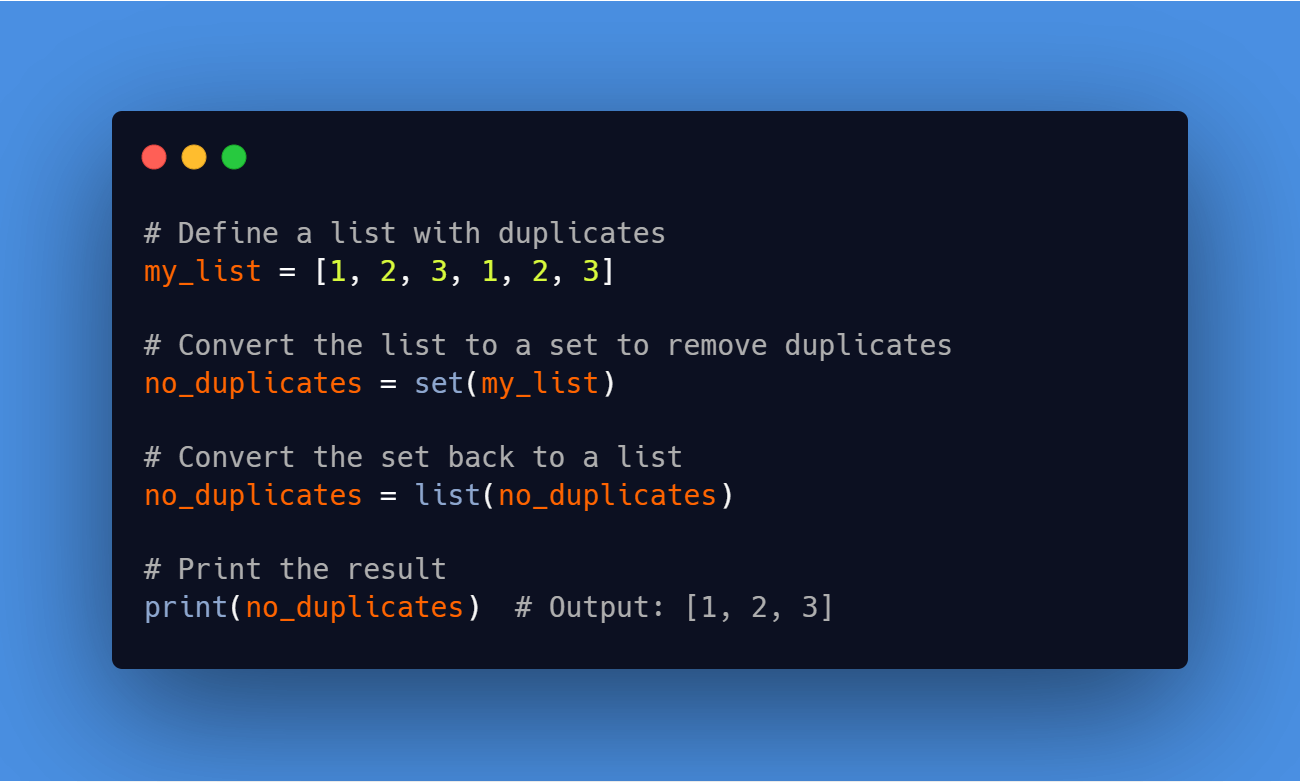When working with data in Python, it’s not uncommon to encounter duplicates.
Whether you’re working with a list, a pandas DataFrame, or some other data structure, removing duplicates can be an important step in your data cleaning process.
In this article, we’ll take a look at a few quick and easy ways to drop duplicates in Python.
Removing Duplicates from a List
The most basic way to remove duplicates from a list is to convert it to a set and then back to a list.
A set is a data structure that does not allow duplicates, so converting a list to a set will automatically remove any duplicates.
Here’s an example of how to do this:
# Define a list with duplicates
my_list = [1, 2, 3, 1, 2, 3]
# Convert the list to a set to remove duplicates
no_duplicates = set(my_list)
# Convert the set back to a list
no_duplicates = list(no_duplicates)
# Print the result
print(no_duplicates) # Output: [1, 2, 3]
Code language: PHP (php)This method works well if you don’t need to preserve the order of the elements in your list.
If you do need to preserve the order, you can use a for loop to iterate through the list and add unique elements to a new list:
# Define a list with duplicates
my_list = [1, 2, 3, 1, 2, 3]
# Create a new list to store the unique elements
no_duplicates = []
# Iterate through the list and add unique elements to the new list
for element in my_list:
if element not in no_duplicates:
no_duplicates.append(element)
# Print the result
print(no_duplicates) # Output: [1, 2, 3]
Code language: PHP (php)Removing Duplicates from a Pandas DataFrame
If you’re working with data in a pandas DataFrame, you can use the DataFrame.drop_duplicates function to remove duplicates. This function takes a few optional arguments, including:
subset: a list of column names to consider when determining duplicates. If you don’t specify this argument, the function will consider all columns.keep: either"first"(to keep the first occurrence of each duplicate row) or"last"(to keep the last occurrence). By default, the function will keep the first occurrence.inplace: a boolean indicating whether to modify the original DataFrame or create a new one. By default, the function will return a new DataFrame.
Here’s an example of how to use the drop_duplicates function to remove duplicates from a DataFrame:
import pandas as pd
# Define a DataFrame with duplicates
df = pd.DataFrame({"A": [1, 2, 3, 1, 2, 3], "B": [4, 5, 6, 4, 5, 6]})
# Drop duplicates
df = df.drop_duplicates()
# Print the result
print(df)
Code language: PHP (php)This will create a new DataFrame with the duplicate rows removed. The resulting DataFrame will look like this:
A B 0 1 4 1 2 5 2 3 6
If you want to keep the last occurrence of each duplicate row instead of the first, you can use the keep argument:
import pandas as pd
# Define a DataFrame with duplicates
df = pd.DataFrame({"A": [1, 2, 3, 1, 2, 3], "B": [4, 5, 6, 4, 5, 6]})
# Drop duplicates, keeping the last occurrence
df = df.drop_duplicates(keep="last")
# Print the result
print(df)
Code language: PHP (php)This will create a new DataFrame with the duplicate rows removed, keeping only the last occurrence:
A B 3 1 4 4 2 5 5 3 6
If you want to only consider a subset of columns when determining duplicates, you can use the subset argument. For example, suppose you have a DataFrame with three columns, A, B, and C, and you only want to consider duplicates in the A and B columns:
import pandas as pd
# Define a DataFrame with duplicates
df = pd.DataFrame({"A": [1, 2, 3, 1, 2, 3], "B": [4, 5, 6, 4, 5, 6], "C": [7, 8, 9, 10, 11, 12]})
# Drop duplicates, considering only the A and B columns
df = df.drop_duplicates(subset=["A", "B"])
# Print the result
print(df)
Code language: PHP (php)This will create a new DataFrame with the duplicate rows removed, considering only the A and B columns:
A B C 0 1 4 7 1 2 5 8 2 3 6 9
Conclusion
In this article, we’ve looked at a few quick and easy ways to drop duplicates in Python. Whether you’re working with a list or a pandas DataFrame, there are a number of options available to help you remove duplicates and clean up your data.

Leave a Reply